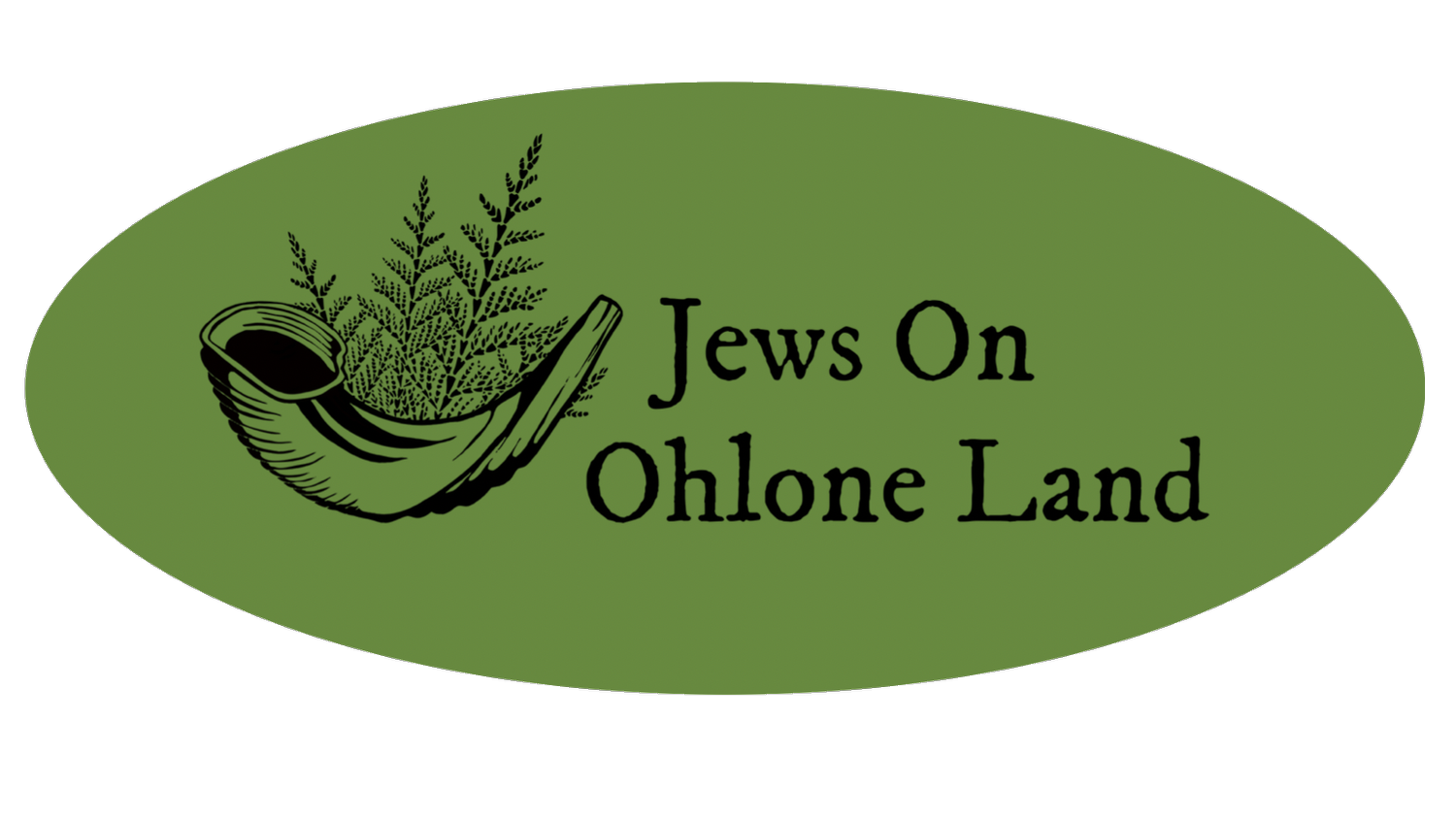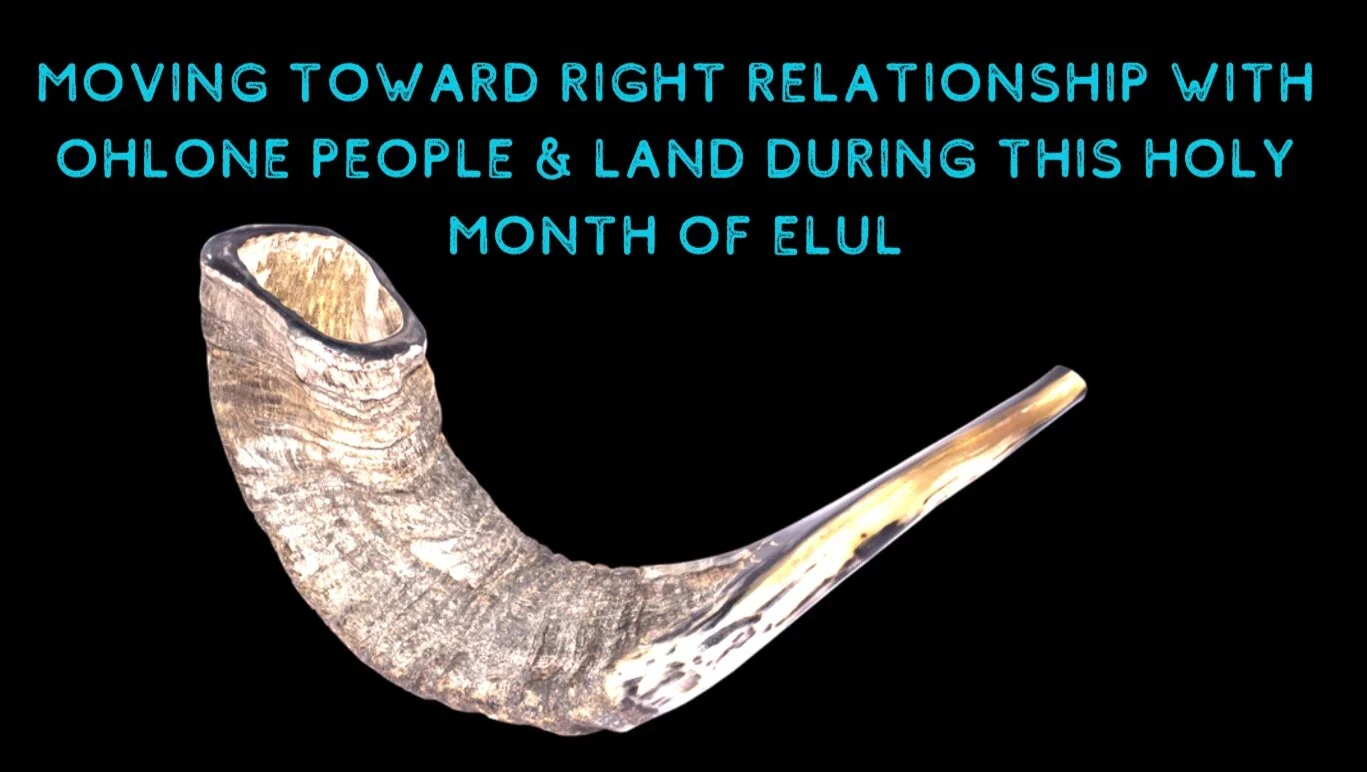This Passover, we place an acorn on our seder plate and support Indigenous rematriation by paying the Shuumi Land Tax.
Here’s a shareable link to this flyer.
Save the West Berkeley Shellmound
“It’s important to have this history known. It’s been an erased history—part of the continuous erasure of our people. What if we were to actually have a place where Ohlone people could talk about not only the past, and how we survived a genocide, but the resilience of still being here today? To talk about what it could look like to be in reciprocity with one another living on this land. Wouldn’t that be a great gift, not only to ourselves, but to future generations of people in the Bay Area?” Corrina Gould, Spokesperson for the Confederated Villages of Lisjan.
Invited by Corrina Gould and the Save the West Berkeley Shellmound campaign, Rabbi Dev Noily shares a prayer at the Spring Equinox candlelight vigil to protect the Shellmound. Rabbi Dev is a co-founder of Jews On Ohlone Land (JOOL). JOOL activates our Jewish communities in solidarity with Indigenous sovereignty.
Prayer at the Shellmound Fence
We come here with pounding hearts,
angry as we witness the desecration of sacred ground.
We come here with broken hearts,
knowing the pain of being cut off from the graves of our ancestors.
We come here with open hearts,
ready to listen to the people, trees, waters, land and ancestors of this place.
We come here with humble hearts,
grateful for the gift of living as guests on Lisjan Ohlone land.
We come here with strong hearts,
committed to answer the call to protect this sacred Shellmound.
We come here with hopeful hearts,
trusting that beyond time and place, all of the ancestors are gathered,
smiling, their hands at our backs, guiding us toward wholeness.
ברוך אתה הבורא מביא רפואה למקומות שבורות
Baruch atah haBorei, meivi refu’ah limkomot sh’vurot
Blessed are You, Creator, who brings healing to broken places.
By Rabbi Dev Noily & Ariel Luckey
Jews On Ohlone Land
Teshuvah is the Jewish practice of relational repair.
It literally means “turning” or “returning.” We practice teshuvah all the time, but with increasing intensity through the month of Elul (leading up to Rosh Hashana), and the days between Rosh Hashana and Yom Kippur. Our tradition teaches that when we practice teshuvah, the day of Yom Kippur affects a kind of spiritual reset for us. We have a clean slate and a new beginning. (Babylonian Talmud Yoma 85b).
We think about repairing relationships both with people, and with G-d / the Source of Life / the truest part of ourselves that is connected with all life. Repair with people involves restorative justice – doing what is necessary to repair the harm we caused and to restore the other person, as much as possible, to their state prior to our harming them.
As Jews living on Ohlone land, we continue to benefit from the harm that was done to Indigenous people here. For those of us who are not Indigenous, we can practice teshuvah by being mindful of whose land we’re on, learning to live as good guests on this land, and engaging in reparation and restoration / rematriation of the land.
Here in the East Bay, we have the amazing gift of Shuumi – a land tax created by Indigenous women that allows non-Indigenous residents to directly support rematriation of the land.
Paying Shuumi is a simple and beautiful act of teshuvah.
#Shofars4Shuumi
Join us in our practice of Teshuvah as we pay the Shuumi Land Tax as Jews on Ohlone Land.
We are activating our Jewish communities to support the powerful work of Sogorea Te’ Land Trust and the rematriation of Ohlone Land.
Join us in this small step towards acknowledging the history of genocide on this land and contributing to its healing.
Tashlich On Ohlone Land
Sunday, September 20th, at the West Berkeley Shellmound & the Berkeley Marina
Jews On Ohlone Land, Kehilla Community Synagogue and Jewish Youth for Community Action co-hosted an outdoor, socially distanced, family friendly, community Tashlich ritual.
We gathered at the West Berkeley Shellmound at 1900 Fourth St for a short program and then walked together to the Berkeley Marina where we held a community Tashlich ritual, sang together and blew our shofars.
An Outdoors Socially Distanced Community Ritual
Sunday, September 20th, at the West Berkeley Shellmound
Practicing Teshuvah as
Jews On Ohlone Land
A Virtual Workshop Facilitated by Ariel Luckey, Leora Cockrell & Mira Stern and Co-Sponsored by Urban Adamah on Wednesday, September 9th, 7-8:30pm
What does it mean for us as Jews to live on Ohlone land? What can we learn from the ways Jewish and Indigenous histories of genocide are similar, and from our vastly different experiences of continuity of place? In this holy month of Elul, how can we move toward right relationship with Ohlone people and land? Through exploration of the history of colonization in the Bay Area, contemporary Indigenous testimony and activism, and our rich tradition of Teshuvah, we’ll explore what we can do to partner with local Indigenous communities and deepen our connection to the land we live on.
The Contemporary Jewish Museum (CJM) sits on the historic Ohlone village site of Sitlintac, a place that hundreds of generations of Indigenous people called home until European colonization began in the late 1700’s. The Gold Rush and the U.S. annexation of California brought with them the final wave of genocide of California’s Indigenous people. California’s Indigenous population plunged from about 150,000 people to just 30,000 survivors between 1846 and 1870. Levi Strauss (1829-1902), arrived in the U.S. from Bavaria in 1847, came to San Francisco in 1853 during the height of the Gold Rush, and built his business selling dry goods to miners.
The CJM’s exhibit on Levi Strauss largely ignores the history of Indigenous genocide during the Gold Rush. The same frenzied markets that brought commercial success to Levi Strauss also brought physical and cultural destruction to California’s Indigenous people. Largely due to direct, physical violence, California’s Indigenous population plunged from about 150,000 people to just 30,000 survivors between 1846 and 1870.
As Jews with histories of genocide, we know how deep the impacts of genocide are across generations, and how painful it is to have our history denied, ignored, or made invisible. We are committed to keeping all stories of genocide visible, especially stories of the land we live on.
We gathered to bear witness to the history of this place, and to surface some of the stories and experiences that are missing from the CJM’s exhibit on Levi Strauss. We gathered to acknowledge that our Bay Area Jewish communities have been built here on a foundation of injustice that requires teshuvah - a process of relational repair, and moving toward right relationship.
Read Rachel Gelman’s powerful statement As a Descendant of Levi Strauss.
Witnessing Indigenous Genocide & Resilience as Jews
Wednesday, February 12th, 2020
At the Contemporary Jewish Museum in San Francisco









